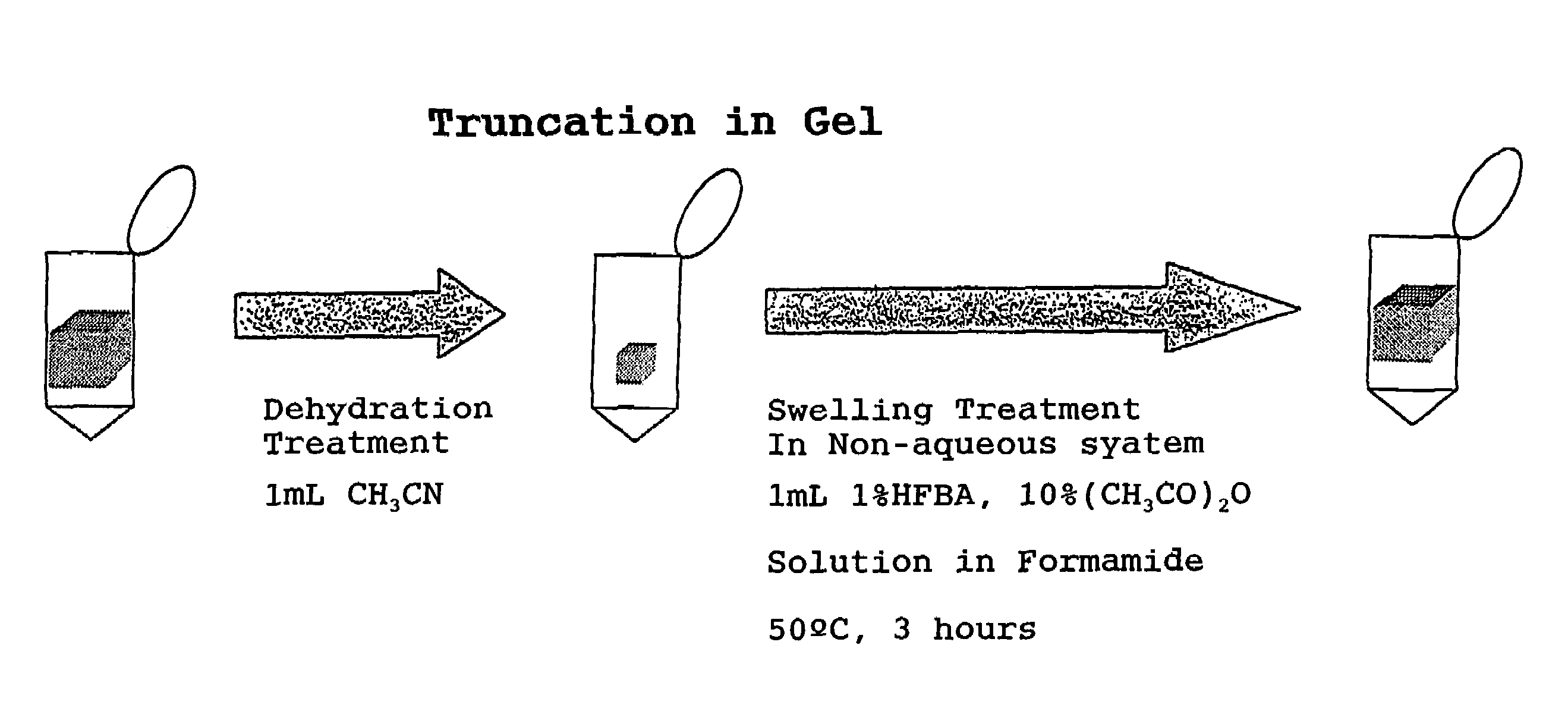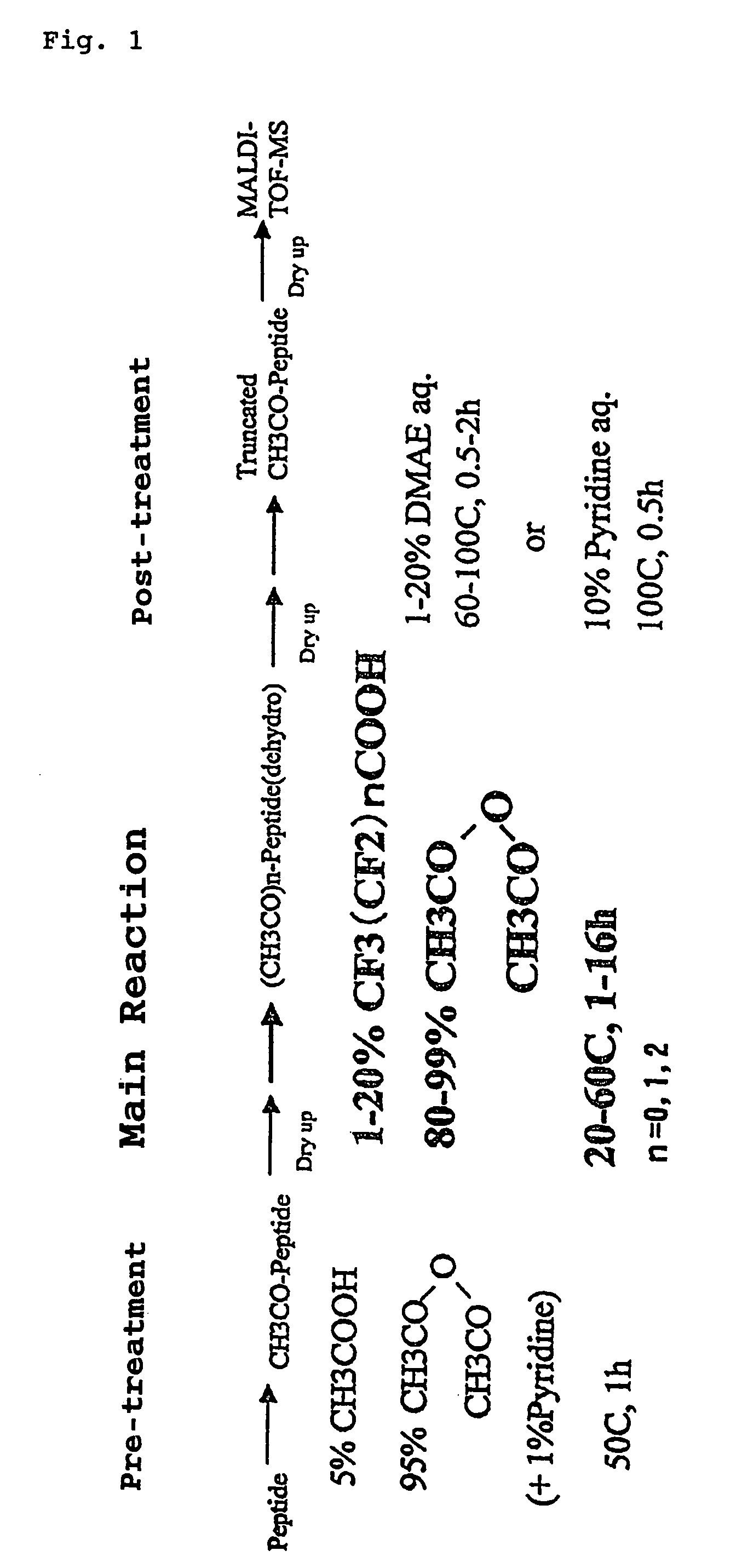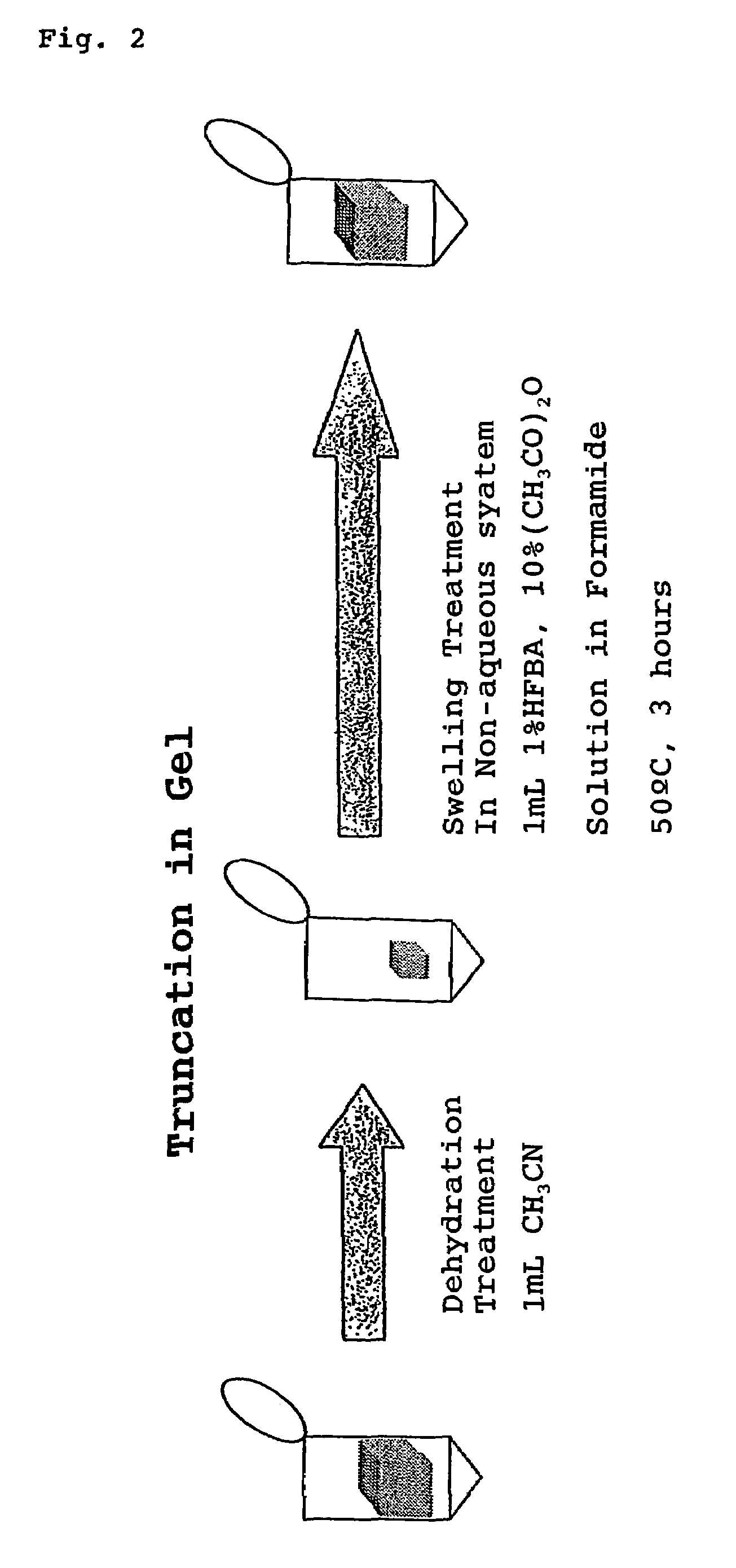[0015]On the other hand, in the above-mentioned method with use of an acetonitrile solution of a perfluoroalkanoic acid anhydride, which allows a vapor of the perfluoroalkanoic acid anhydride generated from the solution to act on a dried peptide under cooling down condition, for example, at −18° C., no water molecule being vaporized from the solution is present in said system and, therefore, the method has such an advantage that the occurrence of the above-mentioned side reactions can be avoided effectively. However, since the reactivity of the perfluoroalkanoic acid anhydride used is high, effective suppression of undesired side reactions is more difficult when the treatment temperature rises higher; therefore, the treatment temperature is required to be kept at such a low temperature as, for example, −18° C. In other words, when the control of the treatment temperature is not enough, there is a high possibility that undesired side reactions are advanced thereby; therefore, in this view, it may be considered that the method still has somewhat weakness in the wide applicability and leaves a room to be improved further. In addition, when water condensation takes place in association with cooling, the resulting water gives rise to deterioration of the reagent used, i.e. deactivation of the perfluoroalkanoic acid anhydride used, which may result in a reduced reactivity on occasion, and thus there remains some anxiety that it may happen to become a serious problem in practical application.
[0017]The present invention solves the above-mentioned problems and aims at providing a method for reaction to release the C-terminal amino acids successively, with use of which method, when a reaction mechanism via formation of oxazolone ring structure as explained above is used to release the C-terminal amino acids from a long peptide chain, undesired side reactions such as cleavage of peptide bond somewhere along the peptide chain can be suppressed and further said chemical treatment itself can be carried out under widely applicable conditions. The present invention also aims at providing a method for easier analysis of C-terminal amino acid sequence of a long peptide chain, wherein there is combined, with the above-mentioned method for reaction to release the C-terminal amino acids successively, a treatment for enzymatic cleavage using such a protease as, when an original peptide and a series of reaction products obtained therefrom are subjected to an enzymatic cleavage treatment using a protease having a site selectivity for cleavage and the resulting peptide fragments are subjected to mass spectrometry, can distinguish more easily the intended peaks for the C-terminal peptide fragments derived from the original peptide and the series of reaction products thereof, from the peaks for other peptide fragments also obtained by enzymatic digestion.
[0021]Further, the present inventors confirmed that, when reactive functional groups of peptide, such as hydroxy group and amino group on the side chain, which are involved in the rearrangement reaction such as N,O-acyl rearrangement reaction that initiates the cleavage in the middle of peptide, undergo protection and modification by O-acylation to hydroxy group and N-acylation to amino group and then there is carried out a reaction of selectively releasing the C-terminal amino acids of peptide with use of said perfluoroalkanoic acid and alkanoic acid anhydride, which occurs in association with the formation of oxazolone ring structure and subsequent cleavage of the oxazolone ring, undesired side reactions can be avoided more effectively. Specifically explaining, it was found that, when an alkanoic acid anhydride and an alkanoic acid both of vapor phase supplied from a mixture of the alkanoic acid anhydride with a small amount of the alkanoic acid is allowed to act on a dried peptide sample in a dried atmosphere at a temperature selected in a range of 10° C. to 60° C., it is possible to beforehand apply N-acylation by the acyl group derived from said alkanoic acid anhydride, to the N-terminal amino group of the peptide as well as to the side chain amino group of the lysine residue which may be present in the peptide, and O-acylation also by the same acyl group to the side chain hydroxy group of the peptide. It was also found that even for a peptide bound on a gel carrier, the N-acylation to said amino groups and the O-acylation to said hydroxy group are possible when the water impregnated into the gel carrier has been removed sufficiently and then a solution of an alkanoic acid anhydride dissolved in a dipolar aprotic solvent has been infiltrated into the gel carrier to give rise to swelling of the gel.
[0022]Also, the present inventors confirmed the following. That is, at a timing when the reaction for releasing the C-terminal amino acids of peptide is over, there are also present reaction intermediates generated in association with the formation of oxazolone ring structure and subsequent cleavage of the oxazolone ring; it is necessary for the mass spectrometry to be conducted later that the reaction intermediates are subjected to a hydrolysis treatment and the C-termini of reaction products are returned to a form in which carboxy group is exposed; and the hydrolysis treatment can be easily conducted, for example, by contacting the reaction products with an aqueous solution of a basic, nitrogen-containing, aromatic ring compound or a tertiary amine compound. It was also found that, in the hydrolysis treatment using the catalysis of such an organic base, there proceed, in addition to the hydrolysis reaction for cyclic ester in oxazolone ring structure, a hydrolysis reaction for ester in O-acylation-protected hydroxy group, that is, a deprotection in hydroxy group and, meanwhile, there occurs no deprotection in more stable N-acylation protection. Thus, when such a hydrolysis treatment is applied, there remain, in the original peptide chain, N-acylation protections of the N-terminal amino group and the side chain amino group of the lysine residue which may be present in the peptide chain; also in the peptide chain of each reaction product produced from the reaction for releasing C-terminal amino acids, there remain as well, N-acylation protections of the N-terminal amino group and the side chain amino group of the lysine residue which may be present in the peptide chain.
[0024]Moreover, the present inventors proved experimentally that, in the molecular weight measurement for various peptide fragments based on the cationic species and anionic species all generated from ionization treatments to the fragments, by means of MALDI-TOF-MS (Matrix Assisted Laser Desorption Ionization Time-of-Flight Mass Spectrometry), there is apparently a general tendency that, when the peptide fragments have a cationic amino acid residue, particularly an arginine residue at the C-terminus, the peak intensity in the molecular weight measurement based on cationic species is significantly high relative to the corresponding peak intensity in the molecular weight measurement based on anionic species and, when the peptide fragments have no cationic amino acid residue at the C-terminus, the peak intensity in the molecular weight measurement based on anionic species is significantly high relative to the corresponding peak intensity in the molecular weight measurement based on cationic species. Further, the present inventors confirmed that, by utilizing the above general tendency proven experimentally, it is possible in the molecular weight measurement based on the cationic species and anionic species all generated from the ionization treatment, according to the MALDI-TOF-MS, to distinguish, with rationality, said common peptide fragments each having one arginine residue at the C-terminus, from said group of C-terminal side peptide fragments derived from C-terminal side partial amino acid sequence and containing no arginine residue, produced from the original peptide and a series of reaction products thereof. That is, the common peptide fragments each obtained by trypsin-induced cleavage and having one arginine residue at the C-terminus are observed as a single peak at a relatively high intensity in the molecular weight measurement based on cationic species and, in the molecular weight measurement based on anionic species, the intensity of the peak corresponding to the common peptide fragments is relatively low; however, by comparing the results of the two measurements, the common peptide fragments can be identified easily. Meanwhile, in the molecular weight measurement based on anionic species, said group of C-terminal side peptide fragments derived from C-terminal side partial amino acid sequence and containing no arginine residue, produced from the original peptide chain and a series of reaction products thereof are observed as a series of peaks at a relatively high intensity and can be identified easily.
[0025]Based on a series of the above findings, the present inventors found the following matter; that is, even for a long peptide chain constituting, for example, a variety of proteins, analysis of its C-terminal amino acid sequence can be made more easily by employing a series of steps which comprise:
 Login to View More
Login to View More 


